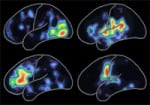Saying Goodbye

Alice and Joseph Shurn, shown at 69 and 70, respectively in 1999, were both educators in Benton Harbor, Mich., and active in the community.
Shurn makes arrangements to have his mother’s body cremated. He will travel with her remains to Benton Harbor for a memorial service, where the community will pay tribute to one of its pillars just as it did for his father.
It’s less than a week after Mrs. Shurn’s death, and four days before her burial at Crystal Springs Cemetery, where she will rest in peace next to her husband. A tear streams down from the outer corner of her son’s right eye as he shares funeral details and reflects on the many “good years” with his mother. He’s wearing black pants and a gray shirt so pale that it’s almost white.
“My life didn’t change,” he said. “As my mother changed, I adjusted.” If she couldn’t eat something, he changed his diet, too. His refrigerator and cabinets are still full of food that reflected her tastes and nutritional needs.
Shurn stresses the importance of being flexible as a caregiver and to overcome any doubts or apprehension about one’s abilities. If he could do it, almost anyone can, he says, even if it means stepping outside one’s comfort zone. Sons can take care of mothers, and daughters can take care of fathers. And although the prospect can be daunting, he also encourages people to consider caring for those with cognitive impairments if they have the right outlook and support systems in place.
“It’s been a challenge that requires patience and commitment,” he acknowledges. And lots of love.
Understanding Dementia: 5 Top Types
Changes in the brain can cause dementia, severely impairing mental abilities including memory, movement, reasoning and thoughts. African-American women and men are two to three times more likely to develop dementia than white Americans.
Sometimes doctors make a general dementia diagnosis, since it can be difficult to pinpoint a specific type and they can overlap. Although Alzheimer’s disease is the most common type, dementia comes in many forms, as described below by the Alzheimer’s Association. Here are the top five:
-
 Alzheimer’s disease accounts for up to 80 percent of dementia. Symptoms can begin long before it has been recognized. Early signs can include depression, apathy and difficulty remembering names or recent activities. It can progress to impaired judgment, movement or swallowing; behavioral changes; and disorientation. Click here to see an interactive tour on how it affects the brain.
Alzheimer’s disease accounts for up to 80 percent of dementia. Symptoms can begin long before it has been recognized. Early signs can include depression, apathy and difficulty remembering names or recent activities. It can progress to impaired judgment, movement or swallowing; behavioral changes; and disorientation. Click here to see an interactive tour on how it affects the brain.
- Blockages in blood vessels and other brain injuries can result in vascular dementia. Accounting for 10 percent of dementia cases, this form has also been known as post-stroke dementia. A person showing early signs of vascular dementia might have problems making decisions, be disorganized or show changes in judgment. Memory loss can vary.
- Alice Shurn’s diagnosis was dementia with Lewy bodies, which is characterized by a buildup of protein deposits called Lewy bodies in nerve cells. It is named for Dr. Frederick H. Lewy, who in the early 1990s discovered the abnormalities in how the brain processes the alpha-synuclein protein. Its brain changes are somewhat similar to those of Alzheimer’s and Parkinson’s disease.
 People with diagnosed with mixed dementia often have some of the symptoms of the top three forms, which could mean more brain problems. It’s unknown how many people have mixed dementia, but experts speculate that the numbers are higher than previously thought, based on autopsies.
People with diagnosed with mixed dementia often have some of the symptoms of the top three forms, which could mean more brain problems. It’s unknown how many people have mixed dementia, but experts speculate that the numbers are higher than previously thought, based on autopsies.
-
- When dementia develops in people with Parkinson’s disease, the symptoms are often similar to Alzheimer’s and Lewy body dementia. Beyond problems with movement, Parkinson’s disease dementia can affect one’s attention span, memory and judgment. About 1 million people, or 2 percent of those 65 and older, have Parkinson’s disease, and up to 80 percent of them develop dementia, according to the National Parkinson Foundation.
Where to Turn: Resources for Dementia Caregivers

African Americans favor home care, and 65 percent are more likely to be primary caregivers compared to other racial and ethnic groups. (Thinkstock/Getty)
-
- The Alzheimer’s Association 24/7 Helpline: (800) 272-3900
- Alzheimer’s and Dementia Caregiver Center
- ARCH –The National Respite Locator Service
- “Because We Care” Forums, Black Women’s Agenda Inc. and AARP
- Community Resource Finder
- Elder Care Locator
- Family Caregiver Alliance
- National Alliance for Caregiving
- Nursing Home Compare and ProPublica to Avoid Those With Problems









